This article was medically reviewed by Shari Forschen, NP, MA. Shari Forschen is a Registered Nurse at Sanford Health in North Dakota. Shari has worked in healthcare since 1996 and her expertise lies in acute care bedside nursing on a medical oncology floor. She received her degree from Medcenter one College of Nursing in 2003 and her Family Nurse Practitioner Masters from the University of North Dakota in 2014. Shari is a member of the American Nurses Association.
There are 8 references cited in this article, which can be found at the bottom of the page.
This article has been viewed 92,071 times.
Research suggests that you may not notice symptoms of high blood pressure at first, but it may still be damaging your heart and blood vessels. Your blood pressure is the force your blood exerts on your blood vessels. Your blood pressure may be low, normal, or high. Experts say that untreated high blood pressure may lead to serious health problems like heart attack, stroke, or kidney problems.[1] On the other hand, low blood pressure may cause dizziness, weakness, fainting, or injury.[2] Fortunately, you may be able to avoid these complications if you monitor your blood pressure to help you catch a problem early.
Steps
Preparing to Test
-
1Purchase a blood pressure monitor. If you are checking your blood pressure at home, purchase an automatic cuff-style monitor. This can help give you the most accurate readings of your pressure in addition to being more simple to use than aneroid sphygmomanometers, which is the technical name of hand-employed blood pressure monitors.[3]
- A digital or automatic monitor has a cuff that inflates at the push of a button and requires no real work from you. This is probably your easiest option if you are monitoring your blood pressure from home.
- Choose a monitor that is validated and approved by an international organization such as the Association for the Advancement of Medical Instrumentation, the British Hypertension Society and the International Protocol for the Validation of Automated BP Measuring Devices.
- Make sure the monitor is properly calibrated — talk to your doctor or a medical supply store about calibration.
- If you have special needs, such as being elderly or pregnant, make sure to choose a monitor specifically suited to your purposes.
- Make sure the cuff fits your arm by measuring the width around your bicep. Most companies make different sizes, which will help you get the most accurate reading possible. Too small of a cuff can cause false elevated readings, too large of a cuff can give false low blood pressure readings.
- You can buy blood pressure monitors at many pharmacies and most medical supply stores. Your insurance company may cover the cost if you’re using the device to manage a medical condition. Make sure you can return or exchange if the apparatus doesn't work or malfunctions.
-
2Set up to check your blood pressure. There are many factors that can affect your blood pressure reading. Preparing yourself for your monitoring test can give the most accurate readings.[4] In preparation for your test:
- Avoid testing right after you wake up.
- Avoid eating or drinking anything for 30 minutes before testing.
- Avoid caffeine and tobacco for 30 minutes before testing.
- Avoid exercising for 30 minutes before testing, even if it’s light walking.
- Empty your bladder.
- Make sure to read the device instructions before you do any testing.
Advertisement -
3Position yourself properly. Before and during the test, it’s important that you position your body and arm properly. Sitting quietly and in a supported, upright position can help you get the most accurate reading.[5]
- Sit down and relax for at least 30 minutes before you test your pressure.
- Do your best to not move or talk during the actual testing.
- Sit with your back straight and supported, such as in a dining room chair. Keep your feet flat on the floor and don’t cross your legs.
- Support your bare arm on a table, desk, or the arm of a chair. Your arm should rest at the level of your heart, for which you might need a pillow or cushion to prop it up.[6]
- The cuff should be directly above the eye, or crook, of your elbow.
Running the Test and Recording Results
-
1Measure at the same time every day. Run the blood pressure monitoring test(s) at the exact same time every day. This can give you the most accurate reading and help you identify potential problems.[7]
- You may want to measure in the mornings and evenings when you are most relaxed. Your doctor may also recommend optimal times for you to run the test.
-
2Inflate the cuff. Once you’ve made the necessary preparations and sat quietly for a while, you can turn on the machine to begin testing. You may need to hit a specific button to inflate the cuff, which you should do as calmly as possible to minimize the risk of elevating your pressure.
- If the cuff becomes uncomfortable or too tight at any juncture, or if you get lightheaded, turn off the machine or engage the emergency release button.
- Continue to remain still while the cuff is inflating.
-
3Remain calm. Once you inflate the cuff, the test should begin. It’s important that you remain as still and calm as possible. This can minimize the risk of getting an inaccurate reading.[8]
- Don’t move or talk while the monitoring is testing if you can avoid it.
- Wait until the testing stops and the cuff deflates or the monitor displays your results.
- Don't forget to breathe and don't take deep breaths — just breathe as you normally would.
-
4Remove the cuff. Some digital monitors will automatically deflate the cuff when they're finished testing, while others may require you to press a button. Once the testing is complete and the air is deflated from the cuff, remove your arm.[9]
- You may feel slightly lightheaded when you remove the cuff. This should subside quickly.
-
5Record your results. It’s important to accurately record your test results as soon as you are able after the monitoring. Record all relevant data in a notebook, on a computer, or see if your device will automatically record your results. These results can help identify trends in your pressure and help your doctor correctly diagnose any issues.[10]
- Note what your blood pressure reading is along with the time and date you took the test. For example, “January 5, 2016 at 10:00am 120/80.”
- The 120/80 would be whatever pressure the test measured. The top number represents your systolic pressure, which measures the pressure in your arteries when your heart beats. The bottom number represents your diastolic pressure, which measures pressure in your arteries between heartbeats.
- A normal reading is a systolic number between 110 and 120. A normal reading for the diastolic number is lower than 80.
-
6Take additional readings. In order to get the most accurate readings and picture of your blood pressure, take one or two additional readings after the first test. Make sure to record the results of these tests as well.[11]
- Wait one to two minutes in between tests to get additional readings.
- Make sure to follow the same procedure for additional tests that you did with the rest. Sit still and remain calm as much as possible.
-
7Consult your doctor. If you notice elevated or low blood pressure over a couple of readings, contact your doctor as soon as possible. This can help minimize the risk of developing conditions that can harm your heart and brain.[12]
- Write down any symptoms that may be occurring with your high or low blood pressure and report these to your doctor. Headaches with elevated blood pressure can indicated potential problems. Dizziness with standing or changing positions can give physicians clues toward a diagnosis.
- In the event that your systolic pressure rises above 180 or your diastolic above 110, seek emergency medical treatment immediately.
- Contact your doctor at any point if you have questions or are unsure of anything.
Expert Q&A
-
QuestionWhat is a healthy blood pressure?
 Shari Forschen, NP, MAShari Forschen is a Registered Nurse at Sanford Health in North Dakota. Shari has worked in healthcare since 1996 and her expertise lies in acute care bedside nursing on a medical oncology floor. She received her degree from Medcenter one College of Nursing in 2003 and her Family Nurse Practitioner Masters from the University of North Dakota in 2014. Shari is a member of the American Nurses Association.
Shari Forschen, NP, MAShari Forschen is a Registered Nurse at Sanford Health in North Dakota. Shari has worked in healthcare since 1996 and her expertise lies in acute care bedside nursing on a medical oncology floor. She received her degree from Medcenter one College of Nursing in 2003 and her Family Nurse Practitioner Masters from the University of North Dakota in 2014. Shari is a member of the American Nurses Association.
Master's Degree, Nursing, University of North Dakota Average normal blood pressure should be 120 – 130/ 60 – 80.
Average normal blood pressure should be 120 – 130/ 60 – 80. -
QuestionWhen a heart appears on the monitor, what does that mean?
 Shari Forschen, NP, MAShari Forschen is a Registered Nurse at Sanford Health in North Dakota. Shari has worked in healthcare since 1996 and her expertise lies in acute care bedside nursing on a medical oncology floor. She received her degree from Medcenter one College of Nursing in 2003 and her Family Nurse Practitioner Masters from the University of North Dakota in 2014. Shari is a member of the American Nurses Association.
Shari Forschen, NP, MAShari Forschen is a Registered Nurse at Sanford Health in North Dakota. Shari has worked in healthcare since 1996 and her expertise lies in acute care bedside nursing on a medical oncology floor. She received her degree from Medcenter one College of Nursing in 2003 and her Family Nurse Practitioner Masters from the University of North Dakota in 2014. Shari is a member of the American Nurses Association.
Master's Degree, Nursing, University of North Dakota The heart symbol on the monitor represents your pulse rate, or each time your heart beats.
The heart symbol on the monitor represents your pulse rate, or each time your heart beats.
References
- ↑ https://medlineplus.gov/highbloodpressure.html
- ↑ https://www.nia.nih.gov/health/high-blood-pressure-and-older-adults
- ↑ https://www.heart.org/en/health-topics/high-blood-pressure/understanding-blood-pressure-readings/monitoring-your-blood-pressure-at-home
- ↑ https://www.health.harvard.edu/heart-health/tips-to-measure-your-blood-pressure-correctly
- ↑ https://www.cdc.gov/bloodpressure/measure.htm
- ↑ https://medlineplus.gov/lab-tests/measuring-blood-pressure/
- ↑ https://www.cdc.gov/bloodpressure/measure.htm
- ↑ https://www.health.harvard.edu/heart-health/tips-to-measure-your-blood-pressure-correctly
- ↑ http://www.mayoclinic.org/diseases-conditions/high-blood-pressure/in-depth/high-blood-pressure/art-20047889?pg=2
About This Article
To monitor your blood pressure, pick up an automatic, cuff-style blood pressure monitor that you can use at home from a pharmacy or medical supply store. Before checking your blood pressure, you need to prepare yourself for an accurate reading by not eating, drinking, or exercising in the 30 minutes before your test. Once you’re ready to run a test, place the cuff in the crook of your elbow, and support that arm on a table or armrest so it’s at the level of your heart. During the test, sit still with your back straight, legs uncrossed, and feet flat on the floor. After your first test, take one or two more, waiting one to two minutes in between each, to get the most accurate reading. For more information from our Medical co-author, including how to record your blood pressure test results, read on!



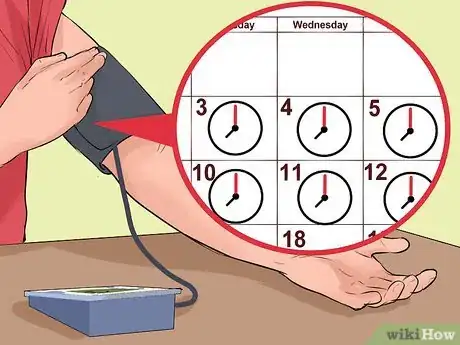
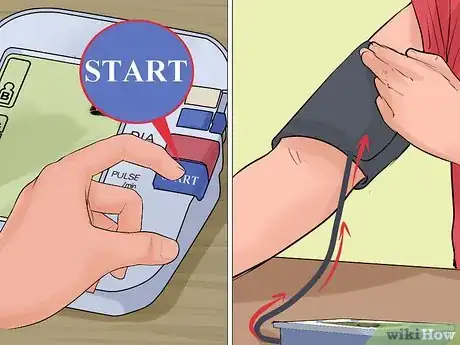

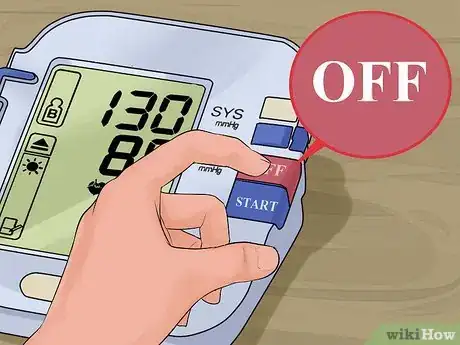
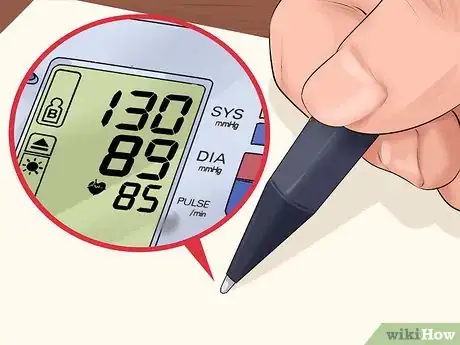
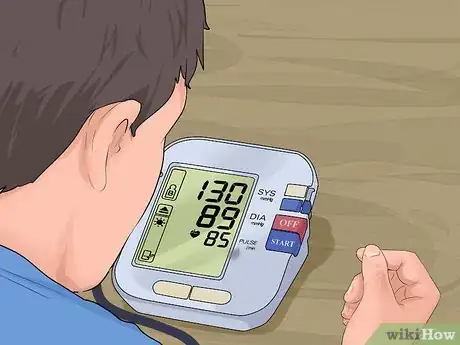






-Step-3-Version-3.webp)

















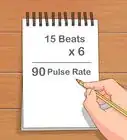



































Medical Disclaimer
The content of this article is not intended to be a substitute for professional medical advice, examination, diagnosis, or treatment. You should always contact your doctor or other qualified healthcare professional before starting, changing, or stopping any kind of health treatment.
Read More...